Shorebirds
Learn more about the shorebirds that stopover and live in the area.
American Avocet (Southern Sask: Breeding)
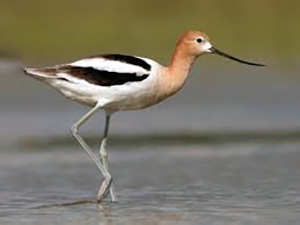
The American Avocet has a long slender bill that is upturned and slightly flattened. It has long pale blue legs and webbed front toes. Breeding adults have the characteristic rusty head and neck, and a black and white body. Non-breeding, or immature birds have a greyish-white head.
Nesting and Mating: They make their homes on shores, lakes, and sloughs, often making their nests in areas with little to no vegetation along dikes or on dried mud shores. Males and females select a nest site together. The nest consists of a shallow depression often lined with grass, feathers, pebbles, or other small objects.
Food: They feed by swishing their bill side to side in the water eating aquatic insects, small crustaceans, dragonfly nymphs, midges, water boatmen, grasshoppers, crickets, weevils, flies and their larvae, small snails and fish, as well as seeds from marsh and aquatic plants.
Young: Typically 3-4 eggs with an 18-30 day incubation period. Avocet young leave the nest within 24 hours of hatching and can walk and swim.
Killdeer (Southern Sask: Breeding)
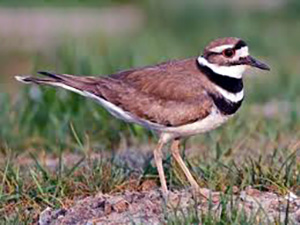
The Killdeer has a short black bill and short sturdy legs. Adults have two black bands on their breast.
Nests and Mating: They make their home in open areas like sandbars, mudflats, and grazed fields. They are also common in residential areas on lawns, driveways, parking lots, etc. The male and female mated pair pick out the nest site together. Their nests are shallow scratches in the ground.
Food: They feed on earthworms, snails, crayfish, grasshoppers, beetles, and aquatic insect larvae. They will also eat seeds left in agricultural areas.
Young: Typically 4-6 eggs. The chicks hatch with a full coat of down feathers and can walk out of the nest as soon as their feathers dry.
Lesser Yellowlegs (Southern Sask: Migration)
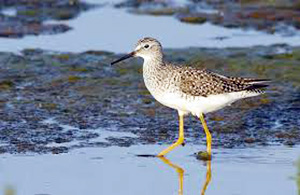
Smaller than the Greater Yellowlegs, Lesser Yellowlegs have bright yellow legs and a thin bill. Breeding adults have more distinct markings with fine grey streaking on the breast and neck. They have a white eye ring and white spots on the back and wings. Non-breeding and juvenile birds have less distinct markings and less streaking and spotting making the breast look smudged. They often will travel in large flocks numbering into the thousands during migration.
Nests and Mating: During migration they are found in shallow, weedy wetlands and flooded fields. The nests tend to be well hidden not far from a water source. The nests are often lined with grass, leaves, and twigs. During breeding they will nest in meadows and open woodlands.
Food: Lesser Yellowlegs are very active when they are foraging using quick jabs of their bill to grab their prey. They will eat snails, flies, beetles, dragonflies, and occasionally small fish or seeds.
Young: Typically 3-5 eggs with an incubation period of 22-23 days. The young are able to walk and feed themselves after hatching and leave the nest after a few hours. Both the male and female provide parental care, however the females often leave the breeding area before the young are able to fly leaving the male to defend them.
Marbled Godwit (Southern Sask: Breeding)
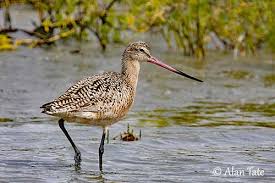
The Marbled Godwit is a large shorebird with dark long legs. They have a long, bi-coloured, sword-like bill that is black at the tip and orange at the base. Breeding adults have barred streaks on their breast and underparts. Non-breeding adults, or immature birds don’t have this streaking, but rather a cinnamon-washed breast and underparts.
Nests and Mating: Breeds in the prairies making their nests in short grasses that are often far from water. Males make a number of shallow depressions in the ground and the female then chooses which one to lay the eggs in. The nests are often lined with grasses and lichen. Once paired, the birds form a monogamous bond for that breeding season. They often return to the same area to mate year after year, often with the same mate.
Food: They feed by using their long bills to probe into the mud or sand eating aquatic invertebrates, earthworms, leeches, and insects.
Young: Typically 3-5 eggs with an incubation period of 23-26 days. The young hatch with their eyes open and are able to walk.
Piping Plover (Sask: Breeding)
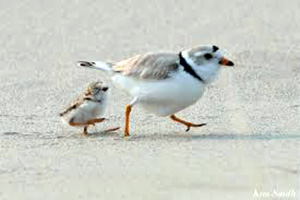
The Piping Plover are small shorebirds with orange legs and bill, big eyes, and a black collar. Their small size and colouring makes it hard for them to spot without binoculars. They blend in on sandy shores and will sometimes will crouch down in a tire track, or footprint and can completely disappear.
Nests and Mating: They tend to nest near small clumps of grass above the waterline in sandy areas including marshes, spoil islands, reservoirs, alkali lakes, and rivers. The male establishes the territory and will make a shallow depression with their feet to use as a nest site. They may make many of these and the pair can take multiple days to decide on which to use. They will often line their nests with small pebbles or bits of shell. Plovers are monogamous with their mate during the breeding season. They will often return to the same site to breed, although may or may not choose the same mate.
Food: Plovers forage for food by running quickly along the beach, stopping frequently and tilting over to peck and probe for prey. They eat marine invertebrates such as worms, small crustaceans, flies, water beetles, snails, and roundworms.
Young: Typically 3-4 eggs with an incubation period of 26-28 days. Both parents incubate the eggs. Once hatched the downy young will leave the nest and can feed on their own within a few hours after drying off. Although they don’t return to the nest, they are carefully guarded by both parents.
Sanderling (Sask: Migration)
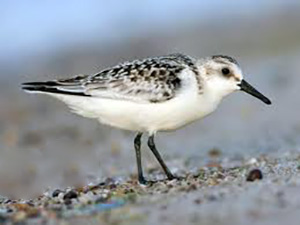
Sanderlings are a medium sized shorebird with a short black bill, black legs, and white underparts. Breeding adults will have a rusty mottling on their back, head, and breast. Non-breeding adults will be pale grey on their head and back. Juveniles will display with a checkered back. During migration you’ll find Sanderling on hard-packed sandy beaches, mud flats, and inland bodies of water such as ponds, streams, reservoirs, and shallow prairie lakes. They roost on beaches in closely packed flocks of up to several thousand.
Nests and Mating: The females will choose a nest site near the shore of a freshwater lake or pond. The nest is usually in a location with little or no vegetation, and may use an existing depression. The nests are lined with leaves, litchens, and occasionally twigs and pebbles. Sanderlings are mostly monogamous, but females may breed with mutiple males in a breeding season. After pairing, the two will accompany each other everywhere.
Food: These fast runners feed by running along the beach with the waves, picking up stranded invertebrates or finding hidden prey in the wet sand. They eat small crabs and crustaceans, worms, mollusks, crane flies, mosquitoes, midges, beetles, butterflies, and moths.
Young: Typically 3-4 eggs with an incubation period of 23-27 days. Both male and female incubate the eggs and look after the young after hatching. The young leave the nest shortly after hatching and have their first flight after around 17 days.
Upland Sandpiper (Sask: Breeding)
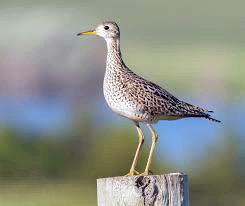
Upland Sandpipers are tall and skinny with a covering of mottled brown above, and spotted on the underside. They have big eyes and short thin bill. Unlike other shorebirds, Upland Sandpipers are found away from wetlands in grasslands, prairies, and croplands. One of the first shorebirds to migrate, it starts its migration south in mid-July.
Nests and Mating: Nests are found in grasslands and native prairie. Males begin the scraping process for the nest site using their feet and breast and the female completes and lines it with grass, leaves, and twigs.
Food: Hunts its prey with jerky steps and quick jabs. They eat mostly insects, but also eat grasshoppers, crickets, weevils, cutworms, beetles, centipedes, snails, ticks, spiders, earthworms, and the larvae of flies, moths, ants, and bugs.
Young: Typically 2-7 eggs with an incubation period of 22-27 days. Both male and female incubate the eggs and tend the young after hatching. The young are able to leave the nest and feed themselves almost immediately hatching, however parents often remain with the young for about one week, or in some cases one parent will remain with the young going forward.
Willet (Sask: Breeding)
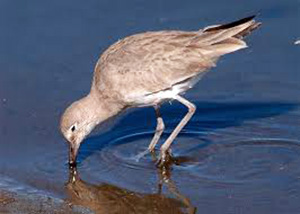
The Willet is a large, stocky shorebird with long legs, a thick, straight bill and a bold black and white stripe running the down the length of each wing. Breeding adults are brown or grey with a mottled plumage and barring on the breast. Western birds tend to be more grey in colour and with lighter markings. Non-breeding or immature birds are more of a greyish brown with few markings.
Nests and Mating: Nests are often found along pond edges, seasonal wetlands, grasslands, and prairies near fresh water. The male and female search for a nest site together with the male making trial scrapings for the female to choose from. Once a nest site is found the male scrapes out a small depression with its feet and breast.
The female lines the nest with surrounding vegetation or grasses. Willet pairs will often stay together for several years and return to the same sites to nest.
Food: They have a sensitive bill tip that allows them to find their prey either day or night. They pause as they walk along the sand and mudflats to probe for worms, mollusks, snails, and insects.
Young: Typically 4 eggs with an incubation period of 22-29 days. Both parents incubate the eggs. They are born with their eyes open and able to move around and peck at vegetation. Both parents raise the young and teach them to eat, although the female may leave the nest up to two weeks ahead of the male, leaving the male to finish raising the chicks.
Baird’s Sandpiper (Sask: Migration)
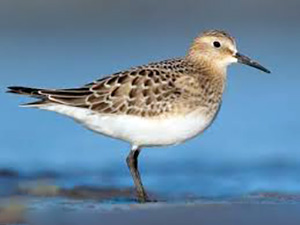
The Baird’s Sandpiper is a medium-sized shorebird with a broad breast, short legs, and black bill. Breeding adults have black spotting on their backs with buff and brown tones. Juveniles tend to have more scaly appearance on their wings and back. They have a large migration journey that takes them from the tip of South America to the Arctic. They stop in a wide variety of habitats during their migration, often stopping near freshwater wetlands including the edges of lakes and rivers, wet farmland, short-grass prairies, and drying lake beds.
Nests and Mating: These birds breed in more arctic locations with males claiming territory as the snow melts. They make their nests in dry tundra next to rocks or under low vegetation. Both the male and female make a scraping that becomes the nest which they then line with plant matter or leave unlined.
Food: Preferring to forage in the mud rather than the water they eat crustaceans, spiders, crane fly larvae, midges, flies, beetles, butterflies, moths, and other arthropods.
Young: Typically have around 4 eggs with an incubation period of 19-22 days. Both adults incubate the eggs and tend the young.
